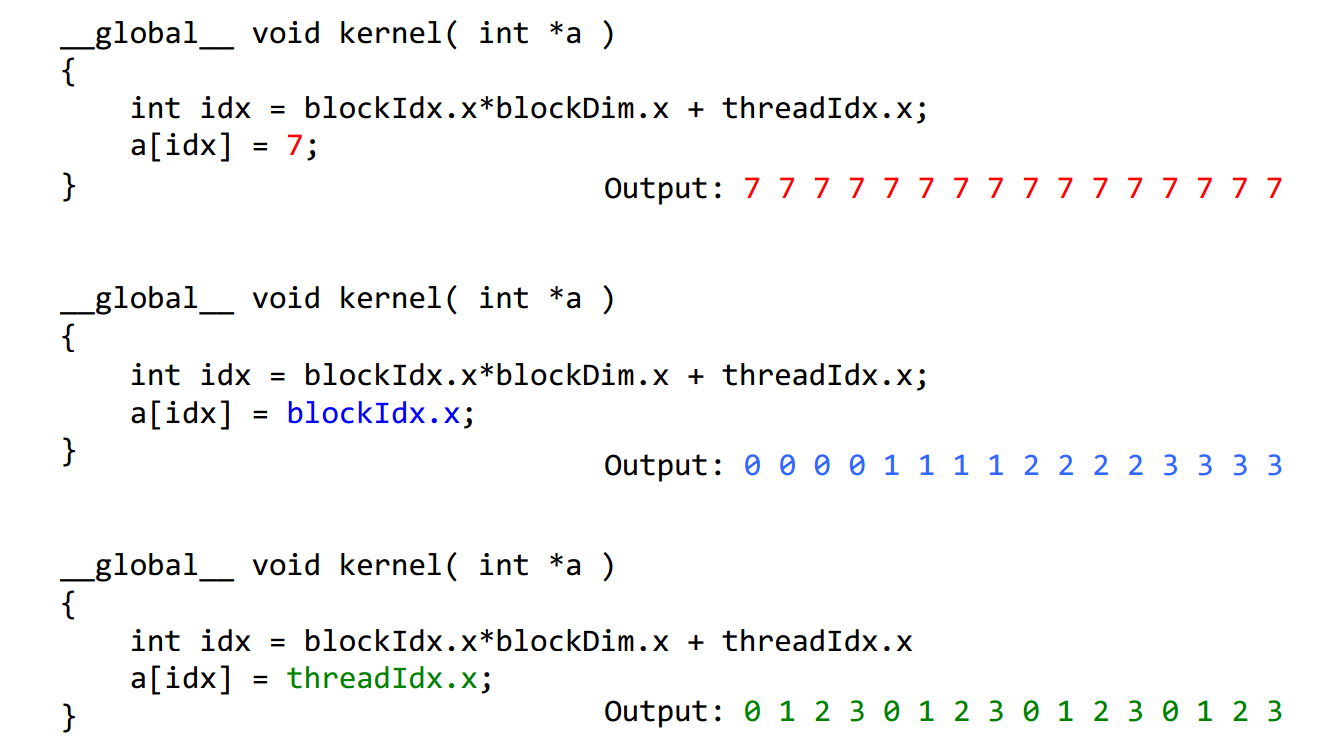CUDA入门1
1GPUs can handle thousands of concurrent threads.
2The pieces of code running on the gpu are called kernels
3A kernel is executed by a set of threads.
4All threads execute the same code (SPMD)
5Each thread has an index that is used to calculate memory addresses that this will access.


1Threads are grouped into blocks
2 Blocks are grouped into a grid
3 A kernel is executed as a grid of blocks of threads
Built-in variables ⎯ threadIdx, blockIdx ⎯ blockDim, gridDim

CUDA的线程组织即Grid-Block-Thread结构。一组线程并行处理可以组织为一个block,而一组block并行处理可以组织为一个Grid。下面的程序分别为线程并行和块并行,线程并行为细粒度的并行,而块并行为粗粒度的并行。addKernelThread<<<1, size>>>(dev_c, dev_a, dev_b);
#include "cuda_runtime.h"
#include "device_launch_parameters.h"
#include <stdio.h>
#include <time.h>
#include <stdlib.h> #define MAX 255
#define MIN 0
cudaError_t addWithCuda(int *c, const int *a, const int *b, size_t size,int type,float* etime);
__global__ void addKernelThread(int *c, const int *a, const int *b)
{
int i = threadIdx.x;
c[i] = a[i] + b[i];
}
__global__ void addKernelBlock(int *c, const int *a, const int *b)
{
int i = blockIdx.x;
c[i] = a[i] + b[i];
}
int main()
{
const int arraySize = ; int a[arraySize] = { , , , , };
int b[arraySize] = { , , , , }; for (int i = ; i< arraySize ; i++){
a[i] = rand() % (MAX + - MIN) + MIN;
b[i] = rand() % (MAX + - MIN) + MIN;
}
int c[arraySize] = { };
// Add vectors in parallel.
cudaError_t cudaStatus;
int num = ; float time;
cudaDeviceProp prop;
cudaStatus = cudaGetDeviceCount(&num);
for(int i = ;i<num;i++)
{
cudaGetDeviceProperties(&prop,i);
} cudaStatus = addWithCuda(c, a, b, arraySize,,&time); printf("Elasped time of thread is : %f \n", time);
printf("{%d,%d,%d,%d,%d} + {%d,%d,%d,%d,%d} = {%d,%d,%d,%d,%d}\n",a[],a[],a[],a[],a[],b[],b[],b[],b[],b[],c[],c[],c[],c[],c[]); cudaStatus = addWithCuda(c, a, b, arraySize,,&time); printf("Elasped time of block is : %f \n", time); if (cudaStatus != cudaSuccess)
{
fprintf(stderr, "addWithCuda failed!");
return ;
}
printf("{%d,%d,%d,%d,%d} + {%d,%d,%d,%d,%d} = {%d,%d,%d,%d,%d}\n",a[],a[],a[],a[],a[],b[],b[],b[],b[],b[],c[],c[],c[],c[],c[]);
// cudaThreadExit must be called before exiting in order for profiling and
// tracing tools such as Nsight and Visual Profiler to show complete traces.
cudaStatus = cudaThreadExit();
if (cudaStatus != cudaSuccess)
{
fprintf(stderr, "cudaThreadExit failed!");
return ;
}
return ;
}
// Helper function for using CUDA to add vectors in parallel.
cudaError_t addWithCuda(int *c, const int *a, const int *b, size_t size,int type,float * etime)
{
int *dev_a = ;
int *dev_b = ;
int *dev_c = ;
clock_t start, stop;
float time;
cudaError_t cudaStatus; // Choose which GPU to run on, change this on a multi-GPU system.
cudaStatus = cudaSetDevice();
if (cudaStatus != cudaSuccess)
{
fprintf(stderr, "cudaSetDevice failed! Do you have a CUDA-capable GPU installed?");
goto Error;
}
// Allocate GPU buffers for three vectors (two input, one output) .
cudaStatus = cudaMalloc((void**)&dev_c, size * sizeof(int));
if (cudaStatus != cudaSuccess)
{
fprintf(stderr, "cudaMalloc failed!");
goto Error;
}
cudaStatus = cudaMalloc((void**)&dev_a, size * sizeof(int));
if (cudaStatus != cudaSuccess)
{
fprintf(stderr, "cudaMalloc failed!");
goto Error;
}
cudaStatus = cudaMalloc((void**)&dev_b, size * sizeof(int));
if (cudaStatus != cudaSuccess)
{
fprintf(stderr, "cudaMalloc failed!");
goto Error;
}
// Copy input vectors from host memory to GPU buffers.
cudaStatus = cudaMemcpy(dev_a, a, size * sizeof(int), cudaMemcpyHostToDevice);
if (cudaStatus != cudaSuccess)
{
fprintf(stderr, "cudaMemcpy failed!");
goto Error;
}
cudaStatus = cudaMemcpy(dev_b, b, size * sizeof(int), cudaMemcpyHostToDevice);
if (cudaStatus != cudaSuccess)
{
fprintf(stderr, "cudaMemcpy failed!");
goto Error;
} // Launch a kernel on the GPU with one thread for each element.
if(type == ){
start = clock();
addKernelThread<<<, size>>>(dev_c, dev_a, dev_b);
}
else{
start = clock();
addKernelBlock<<<size, >>>(dev_c, dev_a, dev_b);
} stop = clock();
time = (float)(stop-start)/CLOCKS_PER_SEC;
*etime = time;
// cudaThreadSynchronize waits for the kernel to finish, and returns
// any errors encountered during the launch.
cudaStatus = cudaThreadSynchronize();
if (cudaStatus != cudaSuccess)
{
fprintf(stderr, "cudaThreadSynchronize returned error code %d after launching addKernel!\n", cudaStatus);
goto Error;
}
// Copy output vector from GPU buffer to host memory.
cudaStatus = cudaMemcpy(c, dev_c, size * sizeof(int), cudaMemcpyDeviceToHost);
if (cudaStatus != cudaSuccess)
{
fprintf(stderr, "cudaMemcpy failed!");
goto Error;
}
Error:
cudaFree(dev_c);
cudaFree(dev_a);
cudaFree(dev_b);
return cudaStatus;
}
运行的结果是
Elasped time of thread is : 0.000010
{103,105,81,74,41} + {198,115,255,236,205} = {301,220,336,310,246}
Elasped time of block is : 0.000005
{103,105,81,74,41} + {198,115,255,236,205} = {301,220,336,310,246}
CUDA入门1的更多相关文章
- CUDA入门
CUDA入门 鉴于自己的毕设需要使用GPU CUDA这项技术,想找一本入门的教材,选择了Jason Sanders等所著的书<CUDA By Example an Introduction to ...
- 一篇不错的CUDA入门
鉴于自己的毕设需要使用GPU CUDA这项技术,想找一本入门的教材,选择了Jason Sanders等所著的书<CUDA By Example an Introduction to Genera ...
- CUDA入门需要知道的东西
CUDA刚学习不久,做毕业要用,也没时间研究太多的东西,我的博客里有一些我自己看过的东西,不敢保证都特别有用,但是至少对刚入门的朋友或多或少希望对大家有一点帮助吧,若果你是大牛请指针不对的地方,如果你 ...
- Cuda入门笔记
最近在学cuda ,找了好久入门的教程,感觉入门这个教程比较好,网上买的书基本都是在掌握基础后才能看懂,所以在这里记录一下.百度文库下载,所以不知道原作者是谁,向其致敬! 文章目录 1. CUDA是什 ...
- CUDA 入门(转)
CUDA(Compute Unified Device Architecture)的中文全称为计算统一设备架构.做图像视觉领域的同学多多少少都会接触到CUDA,毕竟要做性能速度优化,CUDA是个很重要 ...
- CUDA编程->CUDA入门了解(一)
安装好CUDA6.5+VS2012,操作系统为Win8.1版本号,首先下个GPU-Z检測了一下: 看出本显卡属于中低端配置.关键看两个: Shaders=384.也称作SM.或者说core/流处理器数 ...
- CUDA中Bank conflict冲突
转自:http://blog.csdn.net/smsmn/article/details/6336060 其实这两天一直不知道什么叫bank conflict冲突,这两天因为要看那个矩阵转置优化的问 ...
- 【CUDA】CUDA框架介绍
引用 出自Bookc的博客,链接在此http://bookc.github.io/2014/05/08/my-summery-the-book-cuda-by-example-an-introduct ...
- 转:ubuntu 下GPU版的 tensorflow / keras的环境搭建
http://blog.csdn.net/jerr__y/article/details/53695567 前言:本文主要介绍如何在 ubuntu 系统中配置 GPU 版本的 tensorflow 环 ...
随机推荐
- 关于VS2010中的TraceDebugging文件夹浅说
最近一段时间发现C盘莫名其妙的变小了,各种清理各种卸载还是没有.最后只能一个文件夹一个文件夹的找,最后针对“C:\ProgramData”(win7系统)文件夹,发现这个文件夹有3.9GB大小.然后一 ...
- [c#] const 与 readonly
c# 中 const 与 readonly 关键字看似相同,实则不同.重点在于确定值的时间. const const 很简单,就是一个常量,不可以被 static 修饰,因为被 const 修饰的字段 ...
- 容器---List和AbstractList
一.前言 前面我们介绍了Collection及其抽象实现,在JAVA的容器体系里,由Collection派生出来的有两大体系,即List和Map.本文以及后续文章将重点分析List体系.本文将重点分析 ...
- [js开源组件开发]js手机端浮层控件,并有多种弹出小提示,兼容pc端浏览器
js dialog组件,包含alert和confirm的实现 本组件所有的资源均在github上可以查看源代码 GitHub 本dialog的组件的例子请在这里查看 demo dialog js di ...
- Angular 核心概念2
自定义指令 指令增强了 HTML,提供额外的功能 内置的指令基本上已经可以满足我们的绝大多数需要了 少数情况下我们有一些特殊的需要,可以通过自定义指令的方式实现 普通指令 语法 <div hel ...
- linux常识以及常用命令和参数
linux,it人士众所周知,一款稳定.强大.开源的系统,1973年,unix正式诞生,ritchie等人用c语言写出第一个unix内核,之后经过不后人不断的改进,形成现在linux的各个版本,其中比 ...
- javascript宿主对象之window.location
location属性是一个用来存储当前页面URL信息的对象. 下面我们通过循环来列出location对象的完整属性列表: for(var i in location){ if(typeof locat ...
- oracle断电重启之ORA-00600[4194]
1.问题描述 Oracle服务器断电重启以后无法数据库无法正常连接,使用sqlplus envision/envision连接报错.常见的错误有以下这些: ORA-12518: TNS:listene ...
- Centos 7: 打开Samba防火墙端口
firewall-cmd --permanent --add-port=137/tcp firewall-cmd --permanent --add-port=138/tcp firewall-cmd ...
- Mac 以太网连接 报无效的服务器地址 BasicIPv6ValidationError
Mac 以太网连接 报无效的服务器地址 BasicIPv6ValidationError 用Mac这么久,一直是用WiFi连接网络,没搞过以太网连接,我也是醉了 显然 Mac 不能像 Windows ...
